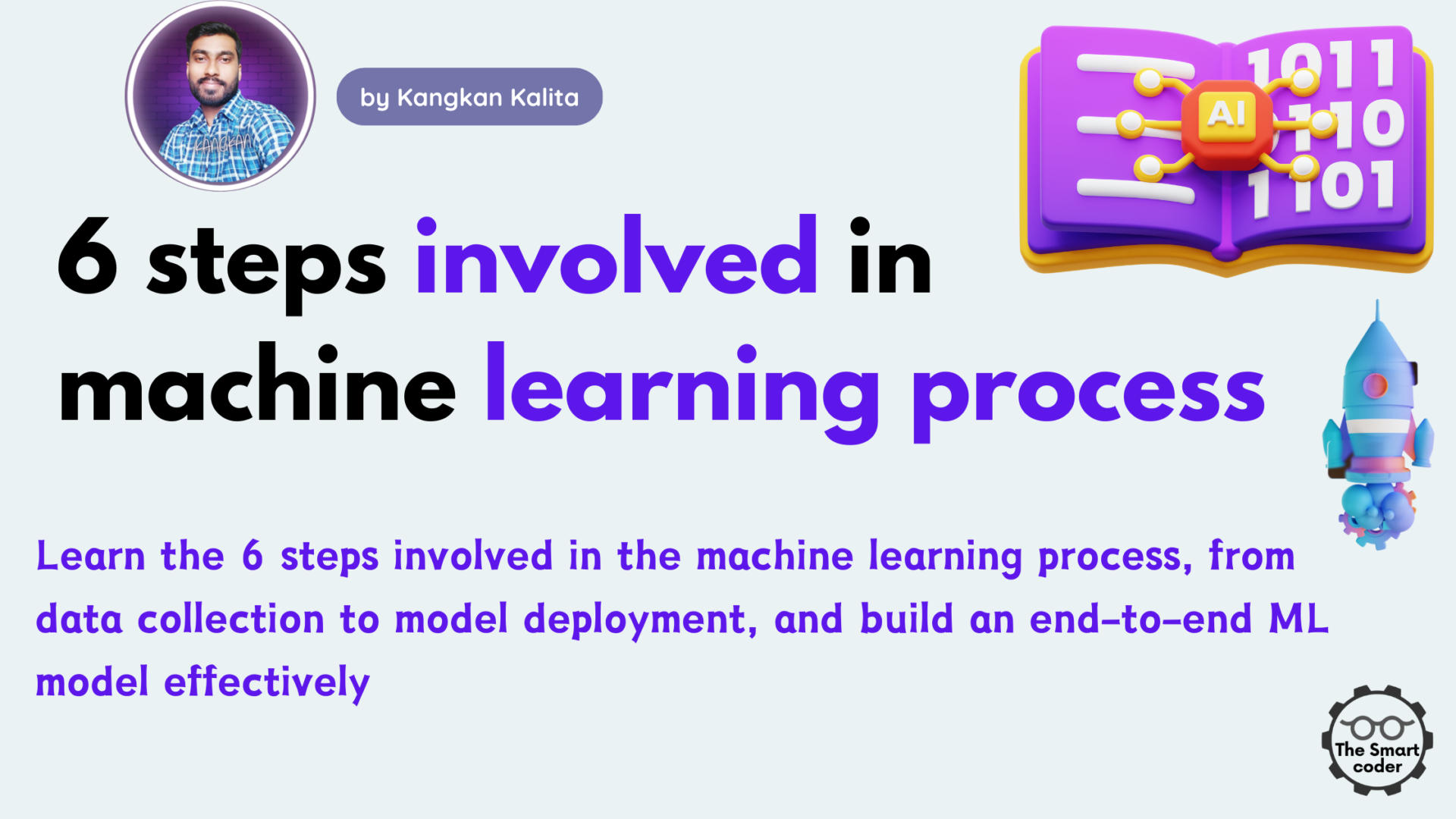6 Steps Involved in Machine Learning Process: Building a Model End to End

Machine learning (ML) is revolutionizing industries by enabling computers to learn from data and make predictions or decisions. Whether it’s recommendation systems, fraud detection, or predictive analytics, machine learning plays a crucial role. However, building a machine learning model from scratch can be daunting. In this article, we’ll break down the 6 steps involved in the machine learning process, guiding you through the journey from raw data to a fully functional model.
Step 1: Defining the Problem and Gathering Data
Every machine learning project begins with a clear understanding of the problem to be solved. Defining the problem correctly sets the foundation for the entire process. Ask yourself:
- What is the goal of the model?
- What kind of data is required to achieve this goal?
- How will the model’s output be used in real-world applications?
Once the problem is well-defined, the next step is data collection. Machine learning models thrive on data, and the quality of the data directly affects model performance. The sources of data may include:
- Public datasets (e.g., Kaggle, UCI Machine Learning Repository)
- Internal company databases
- Web scraping
- APIs from third-party services
At this stage, it’s crucial to gather enough high-quality and representative data that captures the underlying patterns relevant to the problem.
Step 2: Data Preprocessing and Cleaning
Raw data is rarely clean and often contains missing values, inconsistencies, and outliers. Data preprocessing ensures that the dataset is structured and usable. This step includes:
- Handling Missing Values: Filling missing values using mean, median, mode, or advanced techniques like KNN imputation.
- Removing Duplicates: Ensuring that duplicate records do not skew model results.
- Handling Outliers: Detecting and addressing extreme values that may distort the model’s learning.
- Data Normalization/Standardization: Scaling numerical values to ensure uniformity across features.
- Encoding Categorical Data: Converting categorical variables into numerical format using techniques like one-hot encoding or label encoding.
Preprocessing enhances data quality, making it suitable for training a machine learning model.
Step 3: Exploratory Data Analysis (EDA) and Feature Engineering
Before building the model, it is essential to understand the data better. Exploratory Data Analysis (EDA) helps uncover patterns, relationships, and anomalies in the dataset. Key techniques in EDA include:
- Summary Statistics: Understanding the mean, median, variance, and standard deviation of numerical features.
- Data Visualization: Using histograms, scatter plots, and correlation heatmaps to gain insights into feature distributions.
- Detecting Correlations: Identifying relationships between variables using correlation matrices.
Once EDA is complete, feature engineering helps improve model performance by creating new meaningful features or modifying existing ones. This can involve:
- Feature Selection: Choosing only the most relevant variables to reduce dimensionality and improve efficiency.
- Feature Extraction: Transforming data into new formats that enhance model learning (e.g., Principal Component Analysis (PCA)).
- Creating New Features: Generating additional informative features based on domain knowledge.
Step 4: Choosing the Right Model and Training It
With clean and structured data in place, the next step is selecting an appropriate machine learning algorithm. The choice depends on the nature of the problem:
- Supervised Learning (for labeled data)
- Regression (e.g., Linear Regression, Random Forest Regression)
- Classification (e.g., Decision Trees, SVM, Neural Networks)
- Unsupervised Learning (for unlabeled data)
- Clustering (e.g., K-Means, DBSCAN)
- Dimensionality Reduction (e.g., PCA, t-SNE)
- Reinforcement Learning (for sequential decision-making problems)
After selecting the model, the next step is training the model on the dataset. This involves:
- Splitting the dataset into training and test sets (usually 80%-20%).
- Feeding the training data into the model so it learns the patterns.
- Adjusting hyperparameters to optimize performance.
Step 5: Model Evaluation and Tuning
Once the model is trained, it must be evaluated to ensure its accuracy and reliability. The most common evaluation metrics include:
- For Regression Models:
- Mean Absolute Error (MAE)
- Mean Squared Error (MSE)
- R-squared (R²)
- For Classification Models:
- Accuracy, Precision, Recall, and F1-Score
- Confusion Matrix
- ROC-AUC Curve
If the model does not perform well, techniques like hyperparameter tuning and cross-validation can be used to enhance its accuracy. Methods include:
- Grid Search: Testing different combinations of hyperparameters.
- Random Search: Randomly selecting hyperparameter combinations.
- Bayesian Optimization: Using probabilistic methods to find optimal parameters.
Additionally, if the model is overfitting (performing well on training data but poorly on test data), techniques like regularization (L1/L2), dropout (for neural networks), and ensemble learning (bagging and boosting) can help.
Step 6: Deployment and Continuous Monitoring
After achieving satisfactory performance, the final step is deploying the model into production. Deployment can be done using:
- Cloud Platforms (AWS, Google Cloud, Azure)
- APIs (Flask, FastAPI, TensorFlow Serving)
- Edge Devices (IoT and mobile applications)
However, the process does not end here. Machine learning models need continuous monitoring and maintenance to ensure they remain effective. Common monitoring practices include:
- Tracking Model Performance: Using dashboards and logging tools.
- Handling Data Drift: Retraining the model when incoming data patterns change.
- Updating Models: Regularly fine-tuning and improving the model as new data becomes available.
Conclusion
Building a machine learning model from scratch requires careful planning and execution. The 6 steps involved in the machine learning process — problem definition, data preprocessing, exploratory analysis, model training, evaluation, and deployment—form the backbone of an end-to-end ML pipeline.
By following these steps systematically, you can create robust and efficient machine learning models that deliver valuable insights and predictions. Whether you’re a beginner or an experienced data scientist, mastering this process will help you build successful ML applications that can solve real-world problems.
Data Science Projects:
Fake News Detection Using Machine Learning
Health Insurance Cost Prediction Using Machine Learning
Latest Posts:
- SQL for beginners : A Complete Guide
- Predictive Analytics Techniques: A Beginner’s Guide to Turning Data into Future Insights
- Top 10 Data Analysis Techniques for Beginners [2025 Guide to Get Started Fast]
- How to Build a Powerful Data Scientist Portfolio as a Beginner [Step-by-Step 2025 Guide]
- Hypothesis Testing in Machine Learning Using Python: A Complete Beginner’s Guide [2025]






